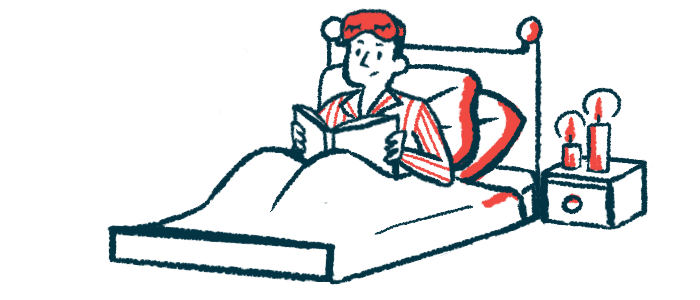Breathing problems during sleep linked to worsening PAH in study
Findings highlight importance of monitoring nighttime oxygen levels

People with pulmonary arterial hypertension (PAH) who have problems breathing while they’re sleeping — causing nocturnal hypoxemia, or oxygen levels in the blood to drop during the night — are nearly twice as likely as patients without such difficulty to experience clinical worsening, a study found.
“The rate of clinical worsening for PAH-related events and mortality was higher in [these patients],” the researchers wrote.
These findings highlight the importance of monitoring nighttime oxygen levels in people with PAH, according to the team.
“Tailored management strategies that address both PAH and nocturnal hypoxemia may be effective in improving clinical outcomes,” they wrote.
The study, “Sleep-disordered breathing patterns and prognosis in pulmonary arterial hypertension: A cluster analysis of nocturnal cardiorespiratory signals,” was published in the journal Sleep Medicine.
Risk nearly 2 times greater for those with problems breathing while sleeping
PAH occurs due to a narrowing of the pulmonary arteries, the blood vessels that supply the lungs. As the blood travels under a higher pressure than normal, it becomes more difficult for the heart’s right ventricle (bottom chamber) to pump blood through to the lungs.
Many people with pulmonary hypertension, including PAH, experience obstructive sleep apnea, according to a 2022 study. With this condition, the airway becomes blocked during sleep, causing breathing to slow or stop repeatedly for short times. As a result, patients may not get enough oxygen while they are sleeping.
Now, a team of researchers in China sought to understand if and how experiencing breathing problems while sleeping may result in a worsening of symptoms for people with PAH. To that end, the team reviewed data from patients who had overnight polygraphy, or sleep study, records.
Their study included 386 adults with PAH, who had a mean age of 44.7. A little more than half of the patients (53.4%) were women. The most common cause of PAH, found among 38.1% of the patients, was congenital heart disease, which is present from birth. This was followed by heritable or idiopathic PAH, meaning it’s due to an unknown cause, as seen in 28.5%.
At the time of diagnosis, about half (51.3%) of the patients were classified into World Health Organization (WHO) functional class I or II, which means that they did not experience symptoms at rest. The majority (89.9%) of patients received treatment for PAH.
Overnight polygraphy records revealed that 182 patients — 47.2% or nearly half — had minimal problems breathing while sleeping. About one third, specifically 125 patients, had sleep apnea without significant nocturnal hypoxemia. A total of 79 patients (20.5%) had sleep apnea and severe nocturnal hypoxemia.
Compared with patients in the other two groups, those who had both sleep apnea and severe nocturnal hypoxemia had significantly higher pressure in the pulmonary arteries, suggesting they “may have more severe PAH,” according to the researchers.
These patients also had a significantly lower ratio of tricuspid annular plane systolic excursion (TAPSE), a measure of right ventricle function, divided by the pulmonary arterial systolic pressure (PASP), “signifying more severe right ventricular dysfunction,” the team wrote.
Over a median of 12.1 months, or about one year, clinical worsening was observed in 68 patients, or 17.6%. Among them, 32 (12.8%) died. Overall, clinical worsening was defined as death by any cause, hospitalization for PAH, or disease progression based on poorer exercise capacity or more severe disease symptoms.
Healthcare providers should consider treatment options such as CPAP therapy and nocturnal oxygen supplementation, especially for patients with sleep apnea and [co-occurring] overnight hypoxemia.
People who had both sleep apnea and severe nocturnal hypoxemia were 1.96 times more likely than those without nocturnal hypoxemia to experience clinical worsening, even after considering other factors that may confound the results.
Events reflecting clinical worsening were significantly more frequent in people who had both sleep apnea and severe nocturnal hypoxemia (26.6%) than in those who had minimal trouble breathing in their sleep (12.6%) or sleep apnea without nocturnal hypoxemia (19.2%).
Left ventricular mass index, a measure of heart enlargement and disease, was identified as an independent risk factor for having both sleep apnea and severe nocturnal hypoxemia, even after adjusting for WHO functional class and TAPSE/PASP ratio.
“Our study provides insights into the role of nocturnal cardiorespiratory [heart and breathing] signals in risk stratification for patients with PAH,” the researchers wrote. Those with both sleep apnea and severe nocturnal hypoxemia “were at a significantly higher risk of experiencing clinical worsening events.”
Overall, “these findings highlight the importance of considering both sleep apnea severity, severe hypoxemia, and left ventricular mass for identifying high-risk patients with PAH,” the researchers concluded.
The team also called for better personalized treatment plans for individuals experiencing breathing problems while sleeping.
Among potential strategies are providing patients with nighttime oxygen treatment, or the use of a continuous positive airway pressure (CPAP) machine, which uses mild air pressure to keep breathing airways open during sleep.
“Healthcare providers should consider treatment options such as CPAP therapy and nocturnal oxygen supplementation, especially for patients with sleep apnea and [co-occurring] overnight hypoxemia,” the researchers wrote.








